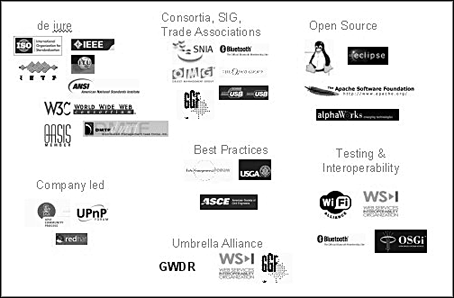| We have already identified that the IT industry is going through major changes. New technology—such as autonomic computing, Web services, and grid computing—is creating tremendous opportunities to massively increase business profitability. The potential of these technologies to transform business is amazing, and open standards will play a critical role in this new e-business on demand world. Just as open standards were critical to the emergence of the Internet and the first generation of e-business, they will play a critical role in the e-business on demand generation. We can define open standards as interfaces or formats that are openly documented and have been accepted in the industry through either formal or de facto processes, and are freely available for adoption by the industry. Examples include HTTP, HTML, WAP, TCP/IP, VoiceXML, XML, and SQL. They are typically built by software engineers and programmers working for software companies that collaborate under known industry standards-based organizations such as the W3C, OASIS, OMA, and IETF. Figure 1.5 illustrates the variety of different standards organizations. Figure 1.5. The landscape of standards organizations. 
The open standards community counts major vendors such as IBM, HP, Sun, Microsoft, Cisco, and Oracle among its active contributors. Other members include Red Hat, Apple, and Intel. These examples are, of course, only a drop among the thousands of other companies involved in these initiatives. Their members also include contributors from the academic and university world, such as Stanford, Berkeley, and MIT. Why are major IT vendors and software companies increasingly interested in open standards? Primarily because investing in these communities makes good business sense. The global computer industry must cooperate in developing the necessary open standards and interfaces to make future technology work and to establish standards that will support an autonomic computing environment. Therefore autonomic computing needs open standards to be successful. IBM strongly agrees that open standards are imperative for the whole e-business on demand strategy. We define open standards as: The specifications that enable the construction of the universal building blocks for the development of software and solutions. The adoption of open standards for autonomic computing may appear a daunting task, as each component of autonomic computing will need to "describe" itself to other software, their resources, and most importantly, their requirements. For example, the self-protection component will need to contact a virus signature vendor and state, "Send me the latest signature file to interface with adaptive algorithms." A final comment on open standards: The days of developing and selling proprietary systems are over and we must go forward together with strategies that will benefit our future industry. Our customers deserve better. |